Transform your planted aquarium into a vibrant underwater paradise with the right commercial products. This guide will teach you how the right blend of micronutrients and macronutrients can unleash the full potential of your aquatic plants. From low-maintenance setups to high-tech aquariums, find the perfect fertilizer to nourish your aquatic flora!

To impress with your planted tank you’ll likely need the help of a few commercial products. I’ve found that an aquarium fertilizer that supplies the right set of micro and macronutrients is one of the best ways to improve the growth and coloration of my aquatic plants.
Nutrition aside, plant food comes in both liquid and root tab form, and you should learn the difference between the two in order to take advantage of each.
In this guide, I will teach you how to choose the best aquarium plant fertilizer for growing dense freshwater vegetation that flourishes with lush colors.
The 9 Best Aquarium Fertilizers for Flourishing Aquatic Plants
| Plant Fertilizer name: | Key Nutrients: | For Aquarium Type: |
|---|---|---|
| 1. Seachem Flourish Root Tabs | All, but slightly lower levels of Nitrogen | Low-maintenance planted fish tanks with easy aquarium plants |
| 2. Seachem Flourish Comprehensive | Trace Micronutrients | Aquarium with plenty of easier freshwater plants and a lot of fish |
| 3. All-in-One Thrive Aquarium Plant Fertilizer | All | Heavily planted fish tanks with shrimp |
| 4. AiO Thrive+ Aquarium Fertilizer | All | A high-tech aquarium with fish, shrimp and demanding freshwater plants |
| 5. Thrive Root Capsule Fertilizer | All | Heavily-planted aquariums with heavier substrates |
| 6. Aqueon Aquarium Plant Food | Trace Micronutrients + some Potassium | High and Low-tech tanks with fish in them |
| 7. Seachem Enhancer NPK | Only Macronutrients | Small aquarium with fewer fish and live plants |
| 8. Osmocote Plus Plant Fertilizer | All | High-tech aquariums that are heavily planted |
| 9. Fluval GRO+ | Micronutrients | Decently planted tank that needs better colors and denser plants |
A good aquarium fertilizer should contain the so-needed plant nutrition for vegetative growth while coming with clear dosage instructions.
That being said, each of the reviewed products has been successfully used by either me or someone I know in real life, where I had the chance to observe their results in person.
Here are the best aquarium fertilizers for thriving aquatic plants:
1. Seachem Flourish Root Tabs – Best for Low Maintenance Setups
Click here to see the current price + more photos on Amazon.com.
To me, Seachem’s plant food tablets are the best aquarium root tabs commercially available because they contain all the essential micronutrients, vitamins, and amino acids for plant growth. These include calcium, iron, potassium, magnesium, inositol, manganese, B12, among others.
Root tabs are ideal aquarium fertilizer for beginners because they require minimum attention and do an excellent job at growing aquatic plants.
I’ve found that the tabs also show fantastic results when used for aquatic plants that form carpets through stolons, such as Dwarf Hairgrass.
Anyway, all you have to do is insert one Flourish tablet into your aquarium substrate so that it can directly and slowly release nutrients to the plant’s roots.
In my experience, Seachem’s Flourish Tabs are a rather set-and-forget-it solution, which I highly appreciate.
The tabs should be buried in the aquarium’s substrate once every couple of months and that’s all the “maintenance” they require.
Speaking of substrates, Seachem’s Flourish Tabs are, in my opinion, the best fertilizer for a planted aquarium with an inert substrate which is usually sand.
In fact, that’s their major use case. If you’ve decided on a planted tank with a sandy substrate and have already researched what live plants would grow best in it then you’re probably in for some root tabs next.
The tabs do not interfere with your water chemistry.
Indeed, the water will always remain crystal clear for your fish to swim around and for you to have a clear view of their shoaling.
Meanwhile, your plants will finally take off within two weeks, putting on a healthy bright green color.
Author’s note: Only use these root tabs in combination with aqua soil if your aquarium houses a lot of very demanding plants.
Anyhow, what I also like about the Flourish Tabs is that the amount of copper they contain is too little to harm your invertebrates such as shrimp and snails.
This in combination with being so beginner-friendly, makes them ideal for people who are just starting out with their first planted shrimp tank.
You also don’t need a lot in the long run. A 5-gallon aquarium with a standard bottom dimensions of 16 x 8 inches requires 3 tabs.
Use that as the standard measure to determine how many tabs you need, depending on the size of your fish tank. Also, the tabs are concentrated enough to last 3 to 4 months.
My recommendation here is to purchase this root tab fertilizer as the sole source of nutrients for low-demand plants in an aquarium with an inert substrate or as a supplement in a high-tech planted fish tank.
Advantages:
- They are easy to use; it’s all about pushing them down the substrate as per the directions;
- One tab lasts for months so you do not have to apply it time and again;
- A good catalyst for promoting the making of Ferrous Oxide, which is vital for the plants’ performance;
- They help with maintaining stable water parameters, which in turn help with keeping algae in check.
- They lack enough macronutrients to be a sole source of food for highly demanding aquarium plants.
2. Seachem Flourish Comprehensive – Ideal for Highly Stocked Planted Tanks
Click here to see the current price + more photos on Amazon.com.
Seachem’s Flourish Comprehensive is a fertilizer mix of trace elements that work best in planted aquariums with fish. The organic waste from the fish would supply the macronutrients to the plants and Flourish will add the otherwise scarce micronutrients in the right quantities.
This plant food combo stimulates explosive vegetative growth in the aquarium.
If you follow the instructions, the results are amazing.
Your plants will start greening fast while sprouting new healthier leaves.
I am particularly fond of Flourish Comprehensive because it is an excellent aquarium fertilizer of micronutrients with adequate iron content.
To get Iron as a separate additive can quickly become pricey, yet it’s a trace element that makes a dramatic difference in plant coloration.
I’m a firm believer that supplementing aquarium plants with the right set of rare micronutrients is somewhat mandatory for any planted fish tank.
Nevertheless, you might say, “oh, but it’s only micro, why leave out the macro?”.
Well, you don’t always have to add macronutrients to your aquarium.
Most of the macro elements are easier to come by in aquariums with fish that produce organic waste.
If your planted aquarium has a heavy bioload, the fish waste will supply part of the macros, namely, Nitrogen and Phosphorus.
In that case, you will only have to provide a Potassium supplement to your plants (visit the link to see one of the many options).
And, mind you, Seachem Flourish Comprehensive has certain quantities of macronutrients as well.
It’s just that they are too small to sustain your aquatic plants in a tank without fish.
Another thing I’d like to mention is that the level of copper in this fertilizer is only 0.0001%.
Of course, this amount of copper won’t harm your shrimp, and other tank inhabitants provided you dose accordingly as per the recommendations.
I would not worry about anything if I used Seachem Flourish as directed.
Anyway, get this micronutrient fertilizer for your aquarium if it is decently stocked with fish.
Seachem Flourish is ideal for use in moderately-planted fish tanks and a good addition as a secondary fertilizer for high-tech aquariums.
Advantages:- It does not interfere with the water parameters;
- A splendid addition to a low-tech aquarium with fish but it’s also a must-have for a high-tech setup;
- Eliminates the need of a separate Iron fertilizer if you want to enjoy vivid plant coloration;
- Fantastic for filling up the nutrient gap in other aquarium plant foods.
- You have to use it in conjunction with macronutrient (N, P, K) supplements if your aquarium does not house fish.
3. All in One Thrive – Best Liquid Aquarium Fertilizer for Ambitious Beginners
Click here to see the current price + more photos on Amazon.
I would say that Thrive likely is the overall best plant food for an aquarium.
It is especially ideal for the newcomers in the hobby because it takes minimal effort to use.
You won’t have to purchase 3 or 4 bottles of different contents because a single bottle of the Thrive will work as an all-in-one fertilizer for your heavily-planted freshwater aquariums.
Combine that with proven results (at least for everyone I’ve seen using it) and that’s enough of a selling point on its own.
A bottle of Thrive is also concentrated enough to equal about 6 standard bottles of other aquarium fertilizers.
In other words, you only need 500 ml of Thrive for a 2500-gallon freshwater tank. Talking of convenience…
I also like the way it is designed in that I do not have to measure every dose.
Thrive’s bottle design makes each pressing of the pump enough to supply plant nutrition for a whole 10-gallon fish tank.
That’s convenient guidance if you don’t feel like measuring drops each time you add fertilizers to your aquarium.
If your fish tank is 20 gallons, you press the pump twice and that’s it.
Anyway, you may see a pretty significant change in your aquarium plants within 2 weeks of use.
In less than a month they will most likely double or triple in size and leaf diameters.
Another impressive quality of Thrive is that it is completely shrimp-safe.
See, when copper is correctly applied it will never harm shrimp or any other invertebrate for that matter.
Still, if you are adamant it may, well, get this product for your aquarium.
The copper content in Thrive is so low it amounts to almost nothing, which is good if you have copper-rich tap water.
I have used the Thrive in my and my clients’ shrimp tanks without any incidents.
I recommend getting the All-in-One Thrive if you’re a beginner at feeding aquarium plants but aim for either moderately or a heavily planted tank that has a professional look to it.
Advantages:
- It is ideal for either high or low-tech setups;
- No complicated procedures to make it ready;
- It prevents algae from springing up in your tank;
- A full refund of your money in case you are not 100% satisfied with the product;
- Clear instructions on the bottle that are easy to understand;
- Up-close customer service by the owners. In case of anything, you can always reach out to them and get your feedback as fast as possible;
- It is very affordable, considering what you get in return.
- Like any other product with nitrogen, it increases nitrates in the water column so you have to schedule water changes;
- Some users have complained that the pump top is somewhat difficult to operate for a tank that holds less than 10 gallons of water.
4. All in One Thrive+ Aquarium Plant Fertilizer – Top Choice for High-Tech Aquariums
Click here to see the current price + more photos on Amazon.
Unlike its predecessor, the All in One Thrive+ Aquarium Plant Fertilizer has increased iron and two separate forms of Nitrogen (organic and inorganic).
On the other hand, it has all the essential micro and macronutrients except magnesium and calcium, which are usually found plenty in an aquarium with a couple of fish.
If you have fish I advise you to ensure that your substrate is inert and contains neither micro nor macronutrients when you use this fertilizer.
Author’s note: Your pH should be 7 or lower, otherwise, part of the concentrated organic nitrogen in it would convert into ammonia and cause a serious spike. At lower pH, the ammonia transforms into ammonium which is not harmful to aquatic inhabitants.
Thrive+ is best used for aquarium plants that grow in tanks with acidic water. These are most high-tech aquariums by definition. Due to its super-high concentration of Nitrogen, this fertilizer should only be used in a densely planted tank with demanding aquatic plants.
Anyhow, one pump dispenses 2 ml, which is enough for a 10-gallon fish tank with a lot of plants competing for food.
Like Thrive, a 500ml of Thrive+ will comfortably treat 2,500 gallons of water.
If you want to see your plants go green and healthy, it’s probably a no-brainer to grab this liquid fertilizer for your freshwater aquarium.
For those of you who may be concerned about their delicate shrimp, you should know that Thrive+ is safe, as long as you keep a solid water change schedule.
It will increase the tank’s Nitrate levels by a significant margin, so do make sure you stay on top of the maintenance.
My recommendation is to get Thrive+ if you plan to look after a high-tech aquarium that’s heavily planted with demanding plant species.
Advantages:- Serves high-tech tanks with difficult aquarium plants;
- It is easy to use with the pump;
- It’s convenient and hassle-free, being all in one and ready to use;
- Refund in case you are not satisfied. Such a guarantee is actually a good sign that the product won’t disappoint if you use it correctly;
- It’s budget-friendly in the long run;
- Instructions are simple enough.
- The fertilizer should be used in aquariums with a pH of no more than 7 if there are living creatures in them (it’s safe for tropical tanks with acidic water and low-pH shrimp tanks though).
5. Thrive Caps Substrate Fertilizer – For Fish Tanks with Heavier Substrates
Click here to see the current price + more photos on Amazon.
First, these are not root tabs but rather capsules.
I do believe the Thrive Caps are the best capsule fertilizers for a freshwater aquarium but with a caveat. The use of this product is somewhat troublesome as the capsules are eager to float.
If your substrate is not dense or somewhat heavy, I recommend looking elsewhere, because each capsule starts degrading as soon as it is in contact with the water.
I don’t find that very convenient, however, the plant growth really is remarkable with these.
One bottle of Thrive Caps Substrate Fertilizer has 60 capsules, each of which weighs 1 gram and is a combination of mineralized topsoil and clay soil rich in iron.
They are also very low in copper content (0.0001%) so don’t hesitate to get some if you were thinking that they could harm your aquarium’s invertebrates.
ThriveCaps is not just safe for your shrimp and snails, but for the fish as well.
Its business is simply to feed macro and micronutrients to your aquatic plants.
If you manage to fit the capsules in the substrate all the nutrients stay there, preventing algae growth or ammonia spikes (as with all root tab fertilizers).
From what I’ve seen, aquatic plants will have a healthy look to them and their growth rate will be more than satisfying when using this fertilizer.
The Thrive capsules are suitable for both low and high-tech planted aquariums.
I suggest getting them if your aquarium’s substrate is not easily stirred – Black Diamond blasting sand, for example.
Advantages:- Each capsule contains all the essential micro and macronutrients for vigorous plant growth;
- Suitable for both high and low demanding aquarium plants;
- A very budget-friendly option, considering how long it will last you.
- It can be annoying to use as the capsule floats effortlessly unless you find a way to keep them grounded into the substrate. (you’ll do it every 3 to 4 months so it should probably not stop you from getting these for your plants).
6. Aqueon Aquarium Plant Food – For tanks with fish and medium-demand plants
Click to compare pricing + see MORE photos of this product at:
The bottle of Aqueon Plant Food clearly states that it “provides macro and micro nutrients” for your freshwater plants to gobble on.
However, I would not use it as an all-in-one solution.
Aqueon Aquarium Plant Food is an aquarium fertilizer that provides all the micronutrients to aquatic plants, except Nitrogen and Phosphorus. This makes it a great addition to planted tanks with high bioloads.
Weirdly, I did experience a minor algae outbreak when I started dosing this one to my tank.
I consider this a good thing because it means that Aqueon’s Aquarium Plant Food actually supports plant growth.
Anyhow, I did reevaluate my dosages and the algae sorted itself out.
Author’s note:One good tip would be to split the recommended dosages into smaller ones and just dose them more often. This way you’ll avoid potential algae issues.
Anyway, since it contains very little Potassium and no Nitrogen or Phosphorus I would not use Aqueon Aquarium Plant Food in planted tanks with no fish.
I’ve used in a community tank that was also heavily planted.
I noticed an almost immediate reaction from my aquatic plants.
Mainly, they looked more healthy, had actual lush colors, and started growing faster.
I do believe that Aqueon Aquarium Plant Food and Seachem’s Flourish are interchangeable.
Flourish seems to be the more popular one, but I don’t think that has to do with its efficiency for plant growth but rather good marketing.
Advantages:- Excellent for planted community tanks;
- Immediate response in plants;
- Convenient use.
- I think the recommended dosage may be overkill and it can trigger a small algae bloom if you’re not careful.
7. Seachem Enhancer NPK – For lightly stocked aquariums with live plants
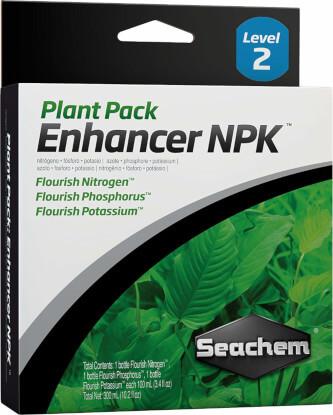
Click here to see the current price + more photos on Amazon.
I consider the Seachem Enhancer NPK one of the best standalone macronutrient options for a planted fish tank that has little to no fish. Enhancer NPK contains all the essential macro ingredients any aquarium plant could ever require from a fertilizer. These macronutrients are not readily available in aquariums with a small bioload.
Anyhow, be prepared to have some time for plant trimming if the growth gets out of hand.
Seachem Enhancer NPK can show significant results very quickly so monitor your tank after you start dosing.
Anyway, if you are new to the game, this fertilizer will likely suit you well because it is easy to use.
Make sure to follow the instructions and control the dosing well.
If you have a browning aquarium plant or aquarium grass you want to see turn green, thick and beautiful like a well-manicured lawn, grab this plant food.
Advantages:- It contains all the macronutrients in one box;
- It is highly concentrated, so a single bottle is ‘one too many’ for a small tank.
- It is rather pricey so if you have a large tank (10 gallons or so) with high nutrient requirements, you may have to dig deeper into your pockets to keep up with it. It favors small, less-demanding planted tanks low on fish stocking;
- It makes the plants grow so fast, so you have to create the time for pruning once in a while (I don’t know about you but with me, that’s part of the fun of keeping an aquarium with live plants).
8. Osmocote Plus – The Budget-Friendly DIY Option
Click here to see the current price + more photos on Amazon.
If you clicked the link to inspect the product on Amazon you probably think that it is somewhat expensive.
Just the opposite – this would likely be a lifetime-long investment for your planted tank as the bag will literally last you for years.
Anyway, I have three or four of those frugal fellows who never let any DIY opportunity pass them by.
If you’re like them, then Osmocote Plus will likely offer you one of those DIY opportunities.
I must admit some DIYs out there are tedious, complicated, and outright time-wasting for me.
However, this is one that I find satisfying and easy.
Here’s a 2-step process to prepare an Osmocote-based aquarium fertilizer:
- Get some cheap, empty gelatine capsules (just make sure they are a 00 Size, such as these here).
- Order a bag of Osmocote Plus and make a pile of your own root capsules in minutes, which eventually last in your aquarium for half a year each.
Osmocote Plus contains all the macronutrients, i.e., nitrogen, phosphorus, and potassium (N, P, K) plus the micronutrients.
The original Osmocote’s NPK ratio is 19-6-12 while Osmocote Plus puts it at 15-9-12, which I think, may yield better results with aquarium plants.
Another difference is that while each of the original Osmocote lasts only four months, Osmocote Plus granules remain active for six months, dutifully providing plant food to the aquarium for longer periods of time.
As far as I’m concerned, what makes the Osmocote Plus fertilizer stand out is its slow-release capability.
Each of its granules controls the timing of fertilizer release. How fast this is, depends on the temperature and how deep it is buried.
The warmer the substrate, the faster the process.
Each granule is covered by a resin coating, and it’s this that controls the nutrients release.
All you have to do is press a capsule of Osmocote Plus deep into the aquarium’s substrate.
Author’s tip: If you have carpeting grass of some sort, bury a capsule between the patches of grass blades and not under them. This way the capsules will promote a faster spread of the grass carpet.
Anyhow, what I’d not recommend is that you crush the granules to dose your water column.
These granules are not designed to work that way.
Unfortunately, I’ve seen some people looking for a quick fix go in that direction.
The result would be green aquarium water as the water column will be overly-nutrified.
This causes microalgae to explosively multiply, which can be difficult to control unless you have a neat UV water sterilizer at hand…
Long story short, just put the granules in gel capsules before putting them in your fish tank.
Anyway, whenever I bring up Osmocote Plus in a discussion about planted aquariums there is always someone to point out that it has a higher copper content.
Osmocote Plus contains 0.05% copper by weight, and not by PPM (parts per million).
The 0.05% contents of copper, however, are not nearly enough to be dangerous to shrimp.
There are plenty of reports online that support this fact if you’d like to – do your research.
As I cite some sources in the fertilizing guide below, copper only becomes toxic to invertebrates if overdosed.
In my experience, Osmocote Plus would be the best fertilizing option for you if you do not mind a super simple DIY project. In return you’ll get a never-ending, low-maintenance supply of quality plant food for your aquariums.
Advantages:- The slow-release mode enables the nutrients to last 6 months on average;
- You cannot easily overdose your aquarium since the slow-release technology controls the dosage. There is no room for excess dosage that could burn your plants, provided you use as per the directions;
- You do not have to dose your plants often;
- Probably the cheapest option in the long run;
- All of the common aquarium plants react extremely well to Osmocote Plus, be it high demand or low demand ones.
- You need to make sure to bury the Osmocote Plus capsules deeply in order to avoid them floating or making your aquarium’s water turbid;
- Higher initial cost (but it still destroys other competing products in the long run, so it’s worth it).
9. Fluval GRO+ – For more colorful and healthier plant growth
Click here to see the current price + more photos on Amazon.com.
So let me share my experience with Fluval GRO+.
Comparing to the most potent aquarium fertilizer on this list (All in One Thrive+) the GRO+ contains significantly less Nitrogen, and lacks some other plant nutrients like Magnesium and Sulfur.
That’s weird since GRO+ does claim it is an all-in-one solution.
Reading the label, however, you’d that see their main strength comes from their micronutrient complex.
But that’s not paper. Let’s talk actual performance in a planted tank.
When I was testing this I followed the instructions closely because I’m not assuming a beginner will try to overdose intentionally.
My tank’s plants reacted almost immediately and there’s a noticeable difference in their colors, probably in the next 2 to 3 days.
This is a very good sign typically, such reaction means that GRO+ worked pretty well in my tank.
The main claim of Fluval’s marketing about this liquid aquarium fertilizer is that it makes plant colors pop more and the plants become healthier.
I’d say my plants exhibited exactly that. After using GRO+ in my tank, they started growing somewhat more “confidently”.
I’d see an improved growth speed and also more and healthier sprouts.
Plant density also seemed to increase. But what really impressed me how lush and brightly colored all vegetation in my aquarium became.
I’d have to say, however, that you shouldn’t get GRO+ if you have 2 to 3 plants randomly scattered around your tank.
You’d want this aquarium fertilizer if your tank has a decent amount of low to medium-demand plants.
The substrate of my tank at the time was already half-way through covered with plants and I still saw some hair algae trying to rear its ugly head.
This means that, even though I followed the dosing instructions, some of the nutrients in GRO+ were left unused.
This gives various freshwater algae the green light to employ them and start growing.
So if you only plan to keep an aquarium with just a few small plants then maybe GRO+ is not for you.
If that’s not the case however, you’d probably be very pleased with this liquid fertilizer since it does a great job as a micronutrient supplement.
Advantages:- Stimulates fantastic plant colors and better plant health
- Decently priced
- Dosing instructions are easy to follow and beginner-friendly
- Results are very quick and noticeable in just a couple of days of use
- Not an all-in-one solution as they claim (lacks in mAcronutrients)
- Not really a disadvantage, but if you have too few plants some algae may sprout in your tank (this means the product is rich in nutrients and it works)
A Complete Beginner’s Guide to Aquarium Plant Fertilizers
I will explain what to look for in this type of product and at the end of this section, you’ll likely be very confident in what suits you best.
So here is a beginner’s guide to choosing the right aquarium plant fertilizer:
1. Should You REALLY Fertilize Aquatic Plants In an Aquarium with Fish?
I have seen some enthusiastic beginners getting surprised when I tell them they should take care of their aquarium plants as much as they take care of their fish.
Here’s whether aquarium plants really need to be fertilized:
Live plants anywhere need nutrients to grow and stay healthy.
However, in an aquarium, the more demanding plants cannot easily obtain the needed plant food as they do in their natural habitat.
Their access is limited by the confinement and supplements are required to make up for the lack of diverse nutrient sources.
Therefore aquarium plants need additional fertilizers to achieve their full growth potential.
Note that pants in an aquarium can still grow without fertilization methods being applied, however, it will happen at a slower pace.
The “natural” approach can also result in reduced maximum size of the plant and less vividness of the leaf coloration.
2. Needed Nutrient Density For Flourishing
To appreciate the need for fertilizers, you need to understand the compositions of the nutrients that make plants thrive.
These are the needed nutrients for aquarium plant growth:
These are macronutrients and micronutrients.
The macronutrients are those that an aquatic plant needs to consume in large quantities.
These are mainly phosphorous (P), nitrogen (N), and potassium (K).
On the other hand, micronutrients are only needed in small amounts by the plants.
They include manganese (Mn), iron (Fe), boron (B), copper (Cu), zinc (Zn), chloride (Cl), and molybdenum (Mo).
If any of these elements are missing from the plant’s diet for a period, it eventually shows symptoms as a warning.
Leaves may wilt, turn yellow, or develop holes depending on which particular nutrient is lacking.
For this reason, all-in-one aquarium fertilizers should contain both macro and micronutrients to provide sufficient food for the aquatic plants.
Here’s a very useful infographic to help you understand what nutrient deficiency can cause in aquarium plants:

3. Nitrate in Tap Water and Fish Waste as Nutrient Sources for Aquatic Plants
There is more in tap water than meets the eye and especially if you decide to use it in your planted aquarium.
It usually contains traces of nitrates and other minerals.
Nitrates are essential nutrients for plants because they’re made of Nitrogen (N), but are not key for plant mass development.
Tap water in the US, for example, is supposed to have no more than 10 ppm of Nitrate-Nitrogen.
For fish keeping purposes this number should be converted to just Nitrate. After the conversion, we find out that the actual quantity of Nitrate that’s allowed in the US tap water equals around 44 ppm.
You should test your tap water and find out if you’ll need to reduce the Nitrate or consider a different water source.
Nitrate is used as a plant food in the aquarium, however, in excess amounts, it will cause more harm than good.
An overabundance of Nitrate in the aquarium water can cause health problems to your freshwater fish.
These include bacterial swim bladder disease, nitrate poisoning in the fish, or heavy hair algae infestations.
Another thing to consider is fish waste. An overstocked fish tank may only need certain microelements as a source of plant food.
Some people may start wondering why they should still use aquarium plant fertilizers, though there already is some fish waste to manure the plants.
That’s a good point. But there is a problem.
Fish wastes will always eventually degrade to Nitrogen (N) and Phosphorus (P).
These components play a vital role in the making of proteins inside the plant’s system.
However, on their own, they cannot finish the job as they are only a fraction of the irreplaceable building blocks.
Therefore, the Nitrogen and Phosphorus in tap water, and the fish waste alone cannot completely sustain aquarium plants.
You’d need an aquarium fertilizer to squeeze the maximum growth potential of your aquatic plants.
4. Differences Between Liquid and Solid Root Tab Fertilizers
First, let’s appreciate the fact that plants are able to absorb nutrients through their leaves, stems, and roots.
But each plant has its more convenient route depending on the ecosystem and its environment.
There are only two aquarium plant fertilizer application methods, and these are:
- Dosing liquid fertilizer into the water column;
- Root-zone fertilization, which involves putting the solid root tabs in the substrate where the plants can absorb the nutrients via roots.
I’ve used one or the other, depending on what I aim to achieve at any given period with particular plants.
Typically, most micronutrient fertilizers come in liquid form, whereas root tabs are an all-in-one solution.
There are factors that should guide you as you decide which is best for every particular situation.
Let’s begin with the liquid fertilizers.
Liquid Aquarium Fertilizers
Once you have measured the recommended amount, you pour it directly into the aquarium.
The aquatic plants will absorb it mainly through their leaves.
There is no long journey from the roots, to the stems, and then to the leaves.
In my personal experience, this is also a good method for rejuvenating aquatic plants that have damaged roots and need food and energy quickly.
Following these thoughts, a huge advantage of aquarium fertilizers in a liquid form is that you can measure precisely how much you dose per session, so you are in full control.
Anyway, the disadvantage of liquid aquarium plant fertilizers is that you have to regularly and consistently repeat dosing to achieve better results.
This is because the content of the fertilizer is used up quickly in the aquarium water, but dosing more than the recommended dose can cause complications for both fish and plants.
This means you should be available to dose every two or so days, depending on the directions or your schedule.
Another drawback is that you have to be precise with the measurements.
This might be a challenge for a beginner unless the product of choice comes with defined pump-like dosing (which the best liquid ones usually have, fortunately).
For comparison, let’s take a look at the solid root tablets.
Solid Root Tabs
In the case of root tabs, you insert a fertilizing tablet in the aquarium’s substrate where the plant’s roots can absorb it over some months as it slowly dissolves.
One advantage is that this long-term storage saves you from the regular labor that comes with water column dosing.
Root tabs are the ideal aquarium plant fertilizer for beginners who don’t like doing diligent maintenance.
With root tabs, it’s not as easy to overdose the fertilizer as when dosing in the water column.
If you don’t know what that is you can visit my guide on planted tank substrates where I’ve discussed it in detail. I’ve linked to it further down in this guide, but you can also use the search bar.
Essentially, it’s the ability of a substrate to “hold” readily available nutrients so that the plants can use them up later, without spoiling the water quality of the aquarium.
For all of this to work better, you need to make an educated choice of a substrate (which is again explained in the link I mentioned).
Anyway, solid tablets and substrates also come with some disadvantages.
One is a lack of precision.
You cannot calculate precisely how long a root tab is going to last. You will have to assume the time for degradation unless the manufacturer states it on the label.
Secondly, only plants close to the substrate may be able to absorb the nutrients fully.
There are also aquatic plants that won’t benefit from a fertilized substrate. For example, if you bury the roots of Java Fern in the aquarium’s substrate they will rot and the plant will die.
A fertilizer is composed of different elements, each of which has its peculiar properties.
Some elements are easily taken in through the leaves, so they are most effective when dosed in the water column.
One such element is potassium (K).
On the other hand, elements that are more chemically active and tend to form bonds easily are generally better stored in the substrate, especially if it has a good CEC value.
There, an exchange between positively charged ions happens, which allows aquarium plants to feed off a more “easily digestible” plant food.
So the better option is having these particular nutrients in the substrate.
For example, ammonia is an organic compound that works better when infused into the substrate.
Plants tend to prefer ammonia over nitrates for their food.
Another thing is that the nitrifying bacteria also oxidize it, and in the end, the plants hardly benefit much from it.
But ammonia in the soil or substrate is unavailable to algae and all those oxidation processes, which is a good thing for aquatic plants.
Having said that, here are the major factors that impact the choice of root tabs versus a liquid fertilizer in an aquarium with plants:
If you don’t want the responsibility of consistently dosing the water column with aquarium fertilizers then use solid root tablets. When using liquid fertilizing products for your aquatic plants, you have more control over dosage which is highly recommended for heavily planted fish tanks.
If used correctly, root tabs do not require a high level of maintenance and are ideal for a low-maintenance aquarium system, also known as “low-tech”.
However, for better control, I recommend using an all-in-one liquid fertilizer for “high-tech” planted aquariums with more difficult plants to grow. This includes colorful aquariums with lots of red plants.
Here’s how a fertilized planted aquarium looks like:
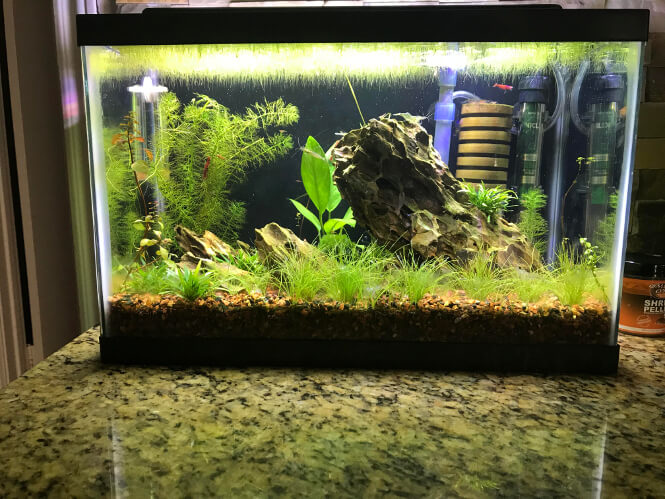
5. Are These Products Dangerous To Freshwater Fish?
If the answer to this question were a firm YES, then I’d have to fold up my tent and exit.
Luckily for us planted tank enthusiasts, it so happens that the answer is not that.
Here is to what degree an aquarium plant fertilizer is safe for fish:
Most manufacturers of aquarium fertilizers are aware that planted tanks are often intended to have live fish in them.
All products are carefully designed and if there’s a possibility that they’d hurt other live aquatic inhabitants it will be clearly stated as a disclaimer on the label.
In the wild, fish, invertebrates, and freshwater plants coexist in the same bodies of water.
It makes sense from an evolutionary point of view that whatever is beneficial for plant life would be safe for aquarium fish and won’t harm them.
There is nothing radically new to fish when being introduced to fertilizers.
To begin with, there are traces of all of the micro and macro elements in the natural water, be it a sea, river, lake, or swamp.
You should ensure that you are not overdosing your aquarium.
The manufacturers of the best fertilizers don’t really like playing with fire and a recommended, carefully calculated dose is always stated on the label.
6. On Copper Contents And Shrimp Safety
I’m obligated to address the issue of shrimp and copper, otherwise, this article will not be worth its salt.
It’s really one of those controversies that seem to generate more heat than light.
The common knowledge is that aquarium plants need copper as a trace element to grow, but copper is said to kill shrimp.
How do you overcome this dilemma if you want a shrimp tank with thriving aquarium plants?
Once, horrified, a friend of mine contacted me, saying all her shrimp had been killed by copper.
Back then I was not really involved in planted tanks.
“Why do you attribute their death to copper?” I asked.
Frankly, that was the first time I was hearing “copper” and “shrimp” in the same sentence.
My friend was more advanced in the whole fish-keeping thing.
“Shrimp are sensitive to copper contents” – she explained.
Since I already had a simple aquarium at home, I immediately looked it up online and indeed several websites were preaching that.
I read thread after thread claiming (without irrefutable mentions of dosage) that copper is highly dangerous for not only shrimp but also snails.
There were also sources stating the opposite, as expected, but that was no consolation for me at the moment.
As is my habit, I went the extra mile and did extensive research.
I did find some interesting information:
First of all, there are traces of copper in fish food.
Some of the foods that we feed to our herbivorous fish such as Cichlids are spirulina, kale, and spinach. These fish foods contain copper even if to a lesser degree.
Another thing to consider is that in some cities, copper sewer pipes are still being used.
This results in some very small amounts of the trace element being released in tap water.
If you use the same water in your aquarium, you have to consider the possibility that some of it may end up on your shrimp’s table.
I’ll gladly take the risk of becoming annoying in the name of shrimp safety and throw it in one more time – the dose makes the poison.
That being said, here is why an aquarium fertilizer that contains copper would be shrimp safe:
Shrimp, like most living things, actually need copper to survive.
Without copper in their blood system, the shrimp would eventually die.
Copper makes up much of the shrimp’s hemocyanin, which is its oxygen-carrying pigment resembling hemoglobin in humans.
Here’s a shot of a low-tech planted shrimp tank that uses plant fertilizers:
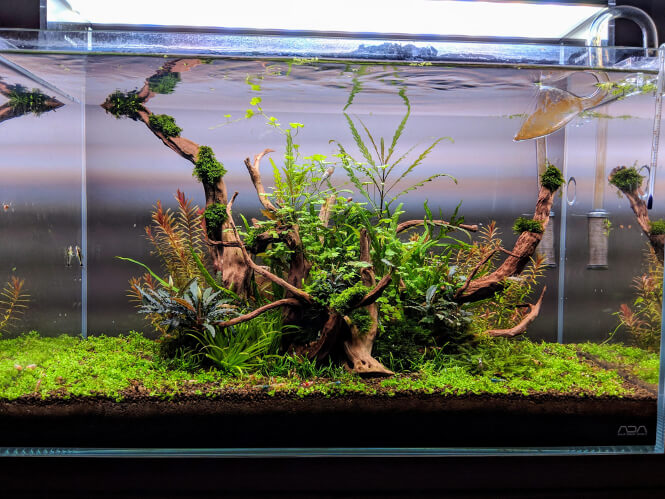
It’s important to remember that excessive amounts of copper can be potentially toxic to all invertebrates. Most manufacturers of fertilizing products meant for aquarium use, take this into consideration and calculate the recommended dosage accordingly.
The added copper in aquarium fertilizers is safe for shrimp when delivered in the right amount.
If an incident occurs it’s likely due to the accumulation of the element in your tap water when combined with the fertilizer.
Make sure everything is in the norm before buying a plant fertilizer with copper for your shrimp aquarium.
In my experience, if someone complains that the copper in a plant fertilizer killed their aquarium shrimp, they did not take tap water into account.
7. Seachem’s Flourish Excel Is NOT a Fertilizer
Let’s take another stop because I have to clarify this one.
The former is the fertilizer while the latter is an algaecide that kills the accumulated biofilm on plants, which makes access to CO2 way easier for the plant.
Aquarium plants would usually get their essential carbon from the carbon dioxide (CO2) in the water column.
However, naturally dissolved CO2 in aquarium water is often not sufficient to stimulate that lush coloration and vigorous plant growth.
This is where Flourish Excel comes in.
Some well-meaning fish-keepers use both of Seachem’s products interchangeably on the assumption that either is a fertilizer.
This can be somewhat understandable if you’re a novice.
After all, at a glance, one would naturally take it for granted that Flourish Excel is an improved version of Flourish.
Flourish Excel is just an organic carbon supplement you can use as a temporary replacement for gaseous CO2 injection.
It should be noted that carbon dioxide injections are the most potent for plant growth between the two and are often used in high-tech planted tanks with more demanding aquatic live plants.
Having one of the top-rated CO2 regulators in your planted aquarium and continuously supplying the tank with CO2 pays off.
Anyway, Excel contains no trace of macro or micronutrients that make up the elements in a fertilizer.
Excel can also be dangerous to fish, because of its active ingredient.
In my experience, a safer dose would be half the recommended one.
8. Concentration of Content
Should your fertilizer of choice be concentrated or somewhat dilute? Well, the answer depends.
Evidently, a more concentrated bottle will comparatively run out slower and may become the cheaper option in the long run.
You only need a few drops per dose.
However, you have to be extra careful with concentrated content because of the possibility of overdosing.
Those few drops could turn out to be “one too many”.
While a minor overdose could be overcome, a massive one has the potential to harm more sensitive aquarium plants or fish.
Just strike the right balance.
I would advise you to follow the instructions on the label to help you measure the right doses.
Most of the fertilizing products I listed here are designed in a way that makes it almost impossible to overdose.
This is a huge part of the whole fertilizing thing when it comes to an aquarium, so it’s a big selling point in my book.
Anyway, with this guide, you should be able to confidently pick the product that would work for you best.
Feed your Aquatic Plants on a Schedule
Could you be feeding your aquatic plants at the wrong time when they better be napping?
The best time to fertilize aquarium plants is in the morning.
This is due to the fact that plants photosynthesize throughout the day, and that’s when they most need or utilize plant food.
An ideal time to feed aquatic plants is within an hour interval after the lights are turned on.
Let me also point out that aquariums are not like the natural settings where lights are on during the day and off at night.
Here, you set the schedule for everything depending on your availability.
In such circumstances, your morning may not be the planted tank’s morning.
What Else Should You Do To Improve Plant Growth?
What more could you do for your little aquatic jungle?
There is more than one factor when it comes to healthy and fast aquarium plant growth.
Remember that photosynthesis can only take place in the presence of light.
And that’s also the right kind of light.
In the absence of the sun, an LED light fixture is your best bet for stimulating this process and giving your plants that beautiful color.
Quality LED aquarium lighting will have the best spectrum and intensity.
To save you a week or so of research I’ve created this guide that considers the best planted tank LED lighting.
Anyhow, another factor that will have a positive impact on the growth of your aquatic plants is the substrate.
Remember, the aquarium substrate is the only earth your aquatic plants know and rely on for support. That’s unless your aquarium harbors floating plants.
There are some substrates that provide a huge amount of plant food by depleting over time and also others that remain inert while being convenient for planting and storing nutrients for further use.
Which one should fit your particular aquarium system? I’ve created a very detailed post on the best substrates for planted aquariums, which you can visit by clicking the link.
It’s a rundown on what substrate is best for what occasion and what to look for in aqua soil.
FAQs
What is the best liquid one for a planted aquarium?
That depends on what kind of planted aquarium you have. There are strong and diluted liquid aquarium fertilizers and what you choose depends on whether your tank is heavily or moderately planted. What makes a liquid fertilizer one of the best is a good formula and the easy dosing.
What is the best one for a low-tech planted tank?
For a low tech planted tank you’d want root tablets as your fertilizer. Root tabs require the least maintenance since you just bury them in the substrate and reload them every couple of months. Since the whole point of a low-tech planted tank is minimal maintenance, root tabs fit the role of a fertilizer ideally.
Which one is safe for shimp in the aquarium?
Aquarium fertilizers contain various amounts of copper which, if too much, can be harmful to shrimp and other invertebrates that you may be keeping.
However, the manufacturers of aquarium fertilizers are aware that most shrimp tanks are likely planted as well. So pretty much all commercially available fertilizers take this into account for their formula and only use amounts of copper that are safe for the invertebrates.
How to fertilize aquarium plants naturally?
The natural fertilizer for aquatic plants in the wild is fish poop. The same can be replicated in an aquarium but the results may not be optimal.
That’s because it’s difficult to find the balance between fish and plants in such a small ecosystem. If you want optimal plant growth in your aquarium your best option would be to use a dedicated plant fertilizer.
My Final Thoughts
You should already have the necessary information to make an educated decision when it comes to aquarium plants and the best choice of fertilizer.
When I was starting my fish-keeping journey, much of these pieces of information I have freely shared here were not available.
You can imagine how difficult it was to figure out what may work and what may not.
I’ve probably said goodbye to more plants than I’d like to admit when I was a beginner…
Keep doing your research and leave me a comment if you need more Aquanswers.

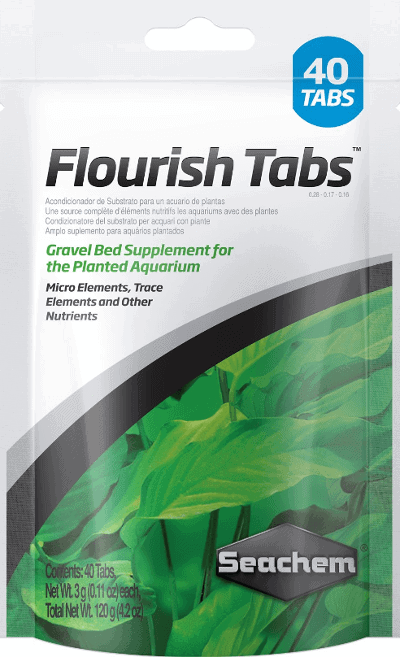

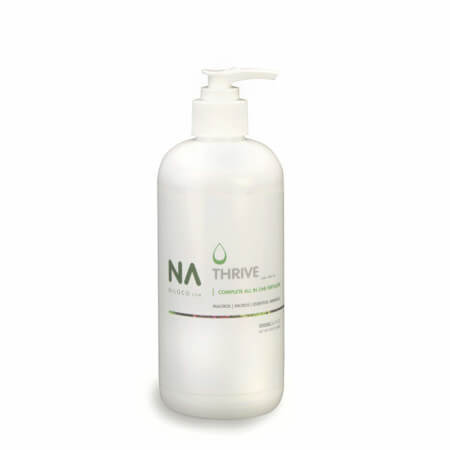




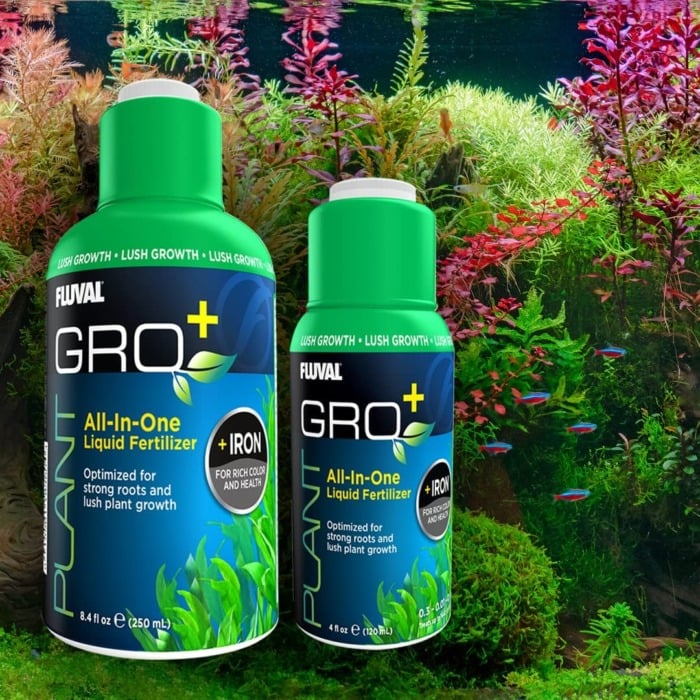
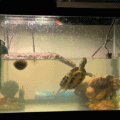
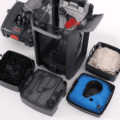


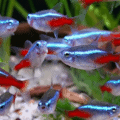
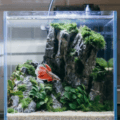

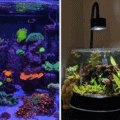
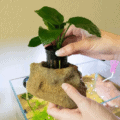
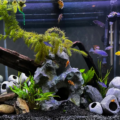
Hello everybody,
First of all, I would like to say thank you for such a good read, really interesting and I gained a lot of information.
I have a planted community tank, I’m dosing it with Seachem Flourish once a week, leave my light on for 6-8hrs a day, do my waterchanges of 40-50% each week….and just recently I made a DIY Co2 system which I can see some good growth on some plants.
My question is, I notice that on some plant leaves they are starting to turn brown almost black…and I’m sure my plants can be more colourful than they are now.
Am I doing something wrong? What can I add or do to make them beautiful and flourish and grow like crazy?
Any help or advice will be appreciated, thank you!